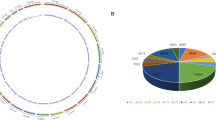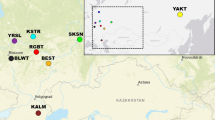Abstract
The evolutionarily conserved serine/threonine kinase, AMP-activated protein kinase (AMPK), functions as a cellular fuel gauge that regulates metabolic pathways in glucose and fatty acid metabolism and protein synthesis, and recent data demonstrate that it also plays a critical role in systemic energy balance. PRKAA2, the gene that encodes the α2 catalytic subunit of AMPK, showed be involved in the glucose and lipid metabolism. To date, genetic variants in human PRKAA2 have been shown associations with type 2 diabetes (T2D) in several populations, but few studies show a complete description of the variability of bovine PRKAA2. In the present study, we reported the investigation of PRKAA2 genetic polymorphisms in three Chinese indigenous bovine breeds [Qinchuan (n = 328), Nanyang (n = 278), Jiaxian (n = 148)] and yak (n = 57). The screening of all exons including adjacent splice sites of the gene was performed using a PCR-SSCP strategy, and following sequence analysis revealed fifteen single nucleotide polymorphisms (SNPs). Five SNPs were identified in exons, which all generate synonymous mutations, and other identified variations were located in introns. Linkage disequilibrium (LD) coefficients and haplotype frequencies for some SNPs were investigated. In total, six haplotypes were found in the cattle breeds. Two LD blocks were found in Qinchuan cattle and three common haplotypes were identified based on four SNPs, with the most common haplotype (TGCT) occurring at a frequency of 53.7%; three of the four possible haplotypes were found in Nanyang cattle, with the most common haplotype (CT) occurring at a frequency of 56.3%; whereas, no suitable haplotypes were found in Jiaxian cattle and yak. Phylogenetic analysis showed that Qinchuan and Jiaxian were firstly clustered together, and then Nanyang was added to the branch. The yak (Poephagus grunniens) diverged strongly from the branch of the Bos Taurus. These data will provide a background for more extensive characterization of the bovine PRKAA2 gene, its diversity in different cattle breeds, and evolutionary information of Chinese cattle breeds.


Similar content being viewed by others
References
Carling D, Clarke PR, Zammit VA, Hardie DG (1989) Purification and characterization of the AMP-activated protein kinase Copurification of acetyl-CoA carboxylase kinase and 3-hydroxy-3-methylglutaryl-CoA reductase kinase activities. Eur J Biochem 186(1–2):129–136
Viollet B, Foretz M, Guigas B, Horman S, Dentin R, Bertrand L, Hue L, Andreelli F (2006) Activation of AMP-activated protein kinase in the liver: a new strategy for the management of metabolic hepatic disorders. J Physiol 574(Pt 1):41–53
Hardie DG, Hawley SA, Scott JW (2006) AMP-activated protein kinase-development of the energy sensor concept. J Physiol 574(Pt 1):7–15
Kahn BB, Alquier T, Carling D, Hardie DG (2005) AMP-activated protein kinase: ancient energy gauge provides clues to modern understanding of metabolism. Cell Metab 1(1):15–25
Hardie DG, Carling D, Carlson M (1998) The AMP-activated/SNF1 protein kinase subfamily: metabolic sensors of the eukaryotic cell? Annu Rev Biochem 67:821–855
Carling D (2004) The AMP-activated protein kinase cascade—a unifying system for energy control. Trends Biochem Sci 29(1):18–24
Hurley RL, Anderson KA, Franzone JM, Kemp BE, Means AR, Witters LA (2005) The Ca2+/calmodulin-dependent protein kinase kinases are AMP-activated protein kinase kinases. J Biol Chem 280(32):29060–29066
Hawley SA, Pan DA, Mustard KJ, Ross L, Bain J, Edelman AM, Frenguelli BG, Hardie DG (2005) Calmodulin-dependent protein kinase kinase-beta is an alternative upstream kinase for AMP-activated protein kinase. Cell Metab 2(1):9–19
Berg AH, Combs TP, Du X, Brownlee M, Scherer PE (2001) The adipocyte-secreted protein Acrp30 enhances hepatic insulin action. Nat Med 7(8):947–953
Woods A, Dickerson K, Heath R, Hong SP, Momcilovic M, Johnstone SR, Carlson M, Carling D (2005) Ca2+/calmodulin-dependent protein kinase kinase-beta acts upstream of AMP-activated protein kinase in mammalian cells. Cell Metab 2(1):21–33
Ting L, Bo W, Li R, Chen X, Wang Y, Jun Z, Yu L (2009) AMP-activated protein kinase supports the NGF-induced viability of human HeLa cells to glucose starvation. Mol Biol Rep 37(6):2593–2598
Musi N, Hirshman MF, Nygren J et al (2002) Metformin increases AMP-activated protein kinase activity in skeletal muscle of subjects with type 2 diabetes. Diabetes 51(7):2074–2081
Zang M, Zuccollo A, Hou X, Nagata D, Walsh K, Herscovitz H, Brecher P, Ruderman NB, Cohen RA (2004) AMP-activated protein kinase is required for the lipid-lowering effect of metformin in insulin-resistant human HepG2 cells. J Biol Chem 279(46):47898–47905
Fryer LG, Parbu-Patel A, Carling D (2002) The Anti-diabetic drugs rosiglitazone and metformin stimulate AMP-activated protein kinase through distinct signaling pathways. J Biol Chem 277(28):25226–25232
Leclerc I, Woltersdorf WW, da Silva Xavier G, Rowe RL, Cross SE, Korbutt GS, Rajotte RV, Smith R, Rutter GA (2004) Metformin, but not leptin, regulates AMP-activated protein kinase in pancreatic islets: impact on glucose-stimulated insulin secretion. Am J Physiol Endocrinol Metab 286(6):E1023–E1031
Musi N, Yu H, Goodyear LJ (2003) AMP-activated protein kinase regulation and action in skeletal muscle during exercise. Biochem Soc Trans 31(Pt 1):191–195
Bolster DR, Crozier SJ, Kimball SR, Jefferson LS (2002) AMP-activated protein kinase suppresses protein synthesis in rat skeletal muscle through down-regulated mammalian target of rapamycin (mTOR) signaling. J Biol Chem 277(27):23977–23980
Minokoshi Y, Kim YB, Peroni OD, Fryer LG, Muller C, Carling D, Kahn BB (2002) Leptin stimulates fatty-acid oxidation by activating AMP-activated protein kinase. Nature 415(6869):339–343
Foretz M, Ancellin N, Andreelli F, Saintillan Y, Grondin P, Kahn A, Thorens B, Vaulont S, Viollet B (2005) Short-term overexpression of a constitutively active form of AMP-activated protein kinase in the liver leads to mild hypoglycemia and fatty liver. Diabetes 54(5):1331–1339
Viollet B, Andreelli F, Jorgensen SB et al (2003) Physiological role of AMP-activated protein kinase (AMPK): insights from knockout mouse models. Biochem Soc Trans 31(Pt 1):216–219
Villena JA, Viollet B, Andreelli F, Kahn A, Vaulont S, Sul HS (2004) Induced adiposity and adipocyte hypertrophy in mice lacking the AMP-activated protein kinase-alpha2 subunit. Diabetes 53(9):2242–2249
Minokoshi Y, Alquier T, Furukawa N et al (2004) AMP-kinase regulates food intake by responding to hormonal and nutrient signals in the hypothalamus. Nature 428(6982):569–574
Fu QY, Gao YQ (2009) Screening of AMP-activated protein kinase alpha2 subunit interacting proteins by bacterial two-hybrid system. Mol Biol Rep 36(2):337–344
Mori Y, Otabe S, Dina C et al (2002) Genome-wide search for type 2 diabetes in Japanese affected sib-pairs confirms susceptibility genes on 3q, 15q, and 20q and identifies two new candidate Loci on 7p and 11p. Diabetes 51(4):1247–1255
Du W, Sun H, Wang H et al (2001) Confirmation of susceptibility gene loci on chromosome 1 in northern China Han families with type 2 diabetes. Chin Med J (Engl) 114(8):876–878
Sun MW, Lee JY, de Bakker PI et al (2006) Haplotype structures and large-scale association testing of the 5’ AMP-activated protein kinase genes PRKAA2, PRKAB1, and PRKAB2 [corrected] with type 2 diabetes. Diabetes 55(3):849–855
Horikoshi M, Hara K, Ohashi J, Miyake K, Tokunaga K, Ito C, Kasuga M, Nagai R, Kadowaki T (2006) A polymorphism in the AMPKalpha2 subunit gene is associated with insulin resistance and type 2 diabetes in the Japanese population. Diabetes 55(4):919–923
Keshavarz P, Inoue H, Nakamura N, Yoshikawa T, Tanahashi T, Itakura M (2008) Single nucleotide polymorphisms in genes encoding LKB1 (STK11), TORC2 (CRTC2) and AMPK alpha2-subunit (PRKAA2) and risk of type 2 diabetes. Mol Genet Metab 93(2):200–209
Spencer-Jones NJ, Ge D, Snieder H, Perks U, Swaminathan R, Spector TD, Carter ND, O’Dell SD (2006) AMP-kinase alpha2 subunit gene PRKAA2 variants are associated with total cholesterol, low-density lipoprotein-cholesterol and high-density lipoprotein-cholesterol in normal women. J Med Genet 43(12):936–942
McKay SD, White SN, Kata SR, Loan R, Womack JE (2003) The bovine 5′ AMPK gene family: mapping and single nucleotide polymorphism detection. Mamm Genome 14(12):853–858
Sambrook J, Russell WD (2001) Molecular cloning: a laboratory manual, vol 3, 3rd edn. Cold Spring Harbor Laboratory Press, New York
Zhang C, Wang Y, Chen H, Lan X, Lei C (2007) Enhance the efficiency of single-strand conformation polymorphism analysis by short polyacrylamide gel and modified silver staining. Anal Biochem 365(2):286–287
Barrett JC, Fry B, Maller J, Daly MJ (2005) Haploview: analysis and visualization of LD and haplotype maps. Bioinformatics 21(2):263–265
Takezaki N, Nei M, Tamura K (2009) POPTREE2: Software for constructing population trees from allele frequency data and computing other population statistics with Windows interface. Mol Biol Evol 27(4):747–752
Stephens JC, Schneider JA, Tanguay DA et al (2001) Haplotype variation and linkage disequilibrium in 313 human genes. Science 293(5529):489–493
Nakamoto K, Wang S, Jenison RD, Guo GL, Klaassen CD, Wan YJ, Zhong XB (2006) Linkage disequilibrium blocks, haplotype structure, and htSNPs of human CYP7A1 gene. BMC Genet 7:29
Saunders MA, Hammer MF, Nachman MW (2002) Nucleotide variability at G6pd and the signature of malarial selection in humans. Genetics 162(4):1849–1861
Saunders MA, Slatkin M, Garner C, Hammer MF, Nachman MW (2005) The extent of linkage disequilibrium caused by selection on G6PD in humans. Genetics 171(3):1219–1229
Toomajian C, Kreitman M (2002) Sequence variation and haplotype structure at the human HFE locus. Genetics 161(4):1609–1623
Clark RM, Linton E, Messing J, Doebley JF (2004) Pattern of diversity in the genomic region near the maize domestication gene tb1. Proc Natl Acad Sci USA 101(3):700–707
Zhang Q, Chen H, Zhao S, Zhang L, Wang X Polymorphisms in the promoter region of bovine PRKAB1 gene. Mol Biol Rep 37(1):435–440
Zhang Q, Chen H, Zhao S, Zhang L, Li F, Wang X (2009) Single nucleotide polymorphisms and haplotypic diversity in the bovine PRKAB1 gene. Mol Biotechnol 43(3):193–199
Zhang Q, Zhao S, Chen H, Liu XL, Zhang L, Li F (2009) Analysis of the codon use frequency of AMPK family genes from different species. Mol Biol Rep 36(3):513–519
Acknowledgments
This study was supported by the National 863 Program of China (No. 2006AA10Z197), National Natural Science Foundation of China (No. 30771544), National Key Technology R&D Program (No. 2006BAD01A10-5), Innovative Foundation of Outstanding Talent from Henan Province (No. 0521001900), Sustaining Program for Topnotch Persons of Northwest A&F University (No. 01140101), and Natural Science Foundation of Xuzhou Normal University (No. 2003XY234).
Author information
Authors and Affiliations
Corresponding author
Electronic supplementary material
Below is the link to the electronic supplementary material.
Rights and permissions
About this article
Cite this article
Zhang, Q., Zhao, S., Chen, H. et al. SNP discovery and haplotype analysis in the bovine PRKAA2 gene. Mol Biol Rep 38, 1551–1556 (2011). https://doi.org/10.1007/s11033-010-0263-3
Received:
Accepted:
Published:
Issue Date:
DOI: https://doi.org/10.1007/s11033-010-0263-3




